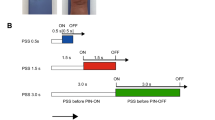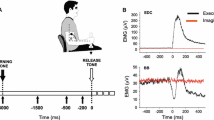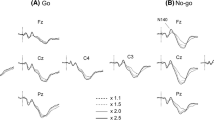Abstract
To reveal whether active attention modulates neuronal responses related to passive attention to somatosensory stimuli presented suddenly against a silent background, we examined the passive attention-related change in amplitude of the event-related brain potentials (ERPs), caused by temporal infrequency of stimuli. Eighteen healthy subjects performed passive and active attention tasks in two stimulus conditions. In the oddball condition, frequent (80%, standard) and infrequent (20%, deviant) electrical stimuli were randomly delivered to the second and third digits of the left hand. In the deviant-alone condition, the deviant stimulus (deviant-alone stimulus) was delivered with the same timing and sequence as in the oddball condition without standard stimuli. The P100, N140, and P200 elicited by the deviant-alone stimulus were enhanced in amplitude compared to those evoked by the oddball deviant stimulus in both the active and passive tasks. Moreover, active attention increased the enhancement of P100 and N140. The difference waveform (deviant-alone minus oddball deviant) provided similar findings. In conclusion, active attention enhances neural responses related to passive shifts of attention to somatosensory signals suddenly presented against a silent background. The results indicate that top-down signals for detecting target stimuli interact with passive shifts of attention caused by bottom-up signals.


Similar content being viewed by others
References
Akatsuka K, Wasaka T, Nakata H, Inui H, Hoshiyama M, Kakigi R (2005) Mismatch responses related to temporal discrimination of somatosensory stimulation. Clin Neurophysiol 116:1930–1937
Allison T, McCarthy G, Wood CC, Williamson PD, Spencer DD (1989) Human cortical potentials evoked by stimulation of the median nerve. II. Cytoarchitectonic area generating long-latency activity. J Neurophysiol 62:711–722
Allison T, McCarthy G, Wood CC (1992) The relationship between human long-latency somatosensory evoked potentials recorded from the cortical surface and from the scalp. Electroencephalogr Clin Neurophysiol 84:301–384
Barba C, Frot M, Guenot M, Mauguiere F (2001) Stereotactic recordings of median nerve somatosensory-evoked potentials in the human pre-supplementary motor area. Eur J Neurosci 13:347–356
Barba C, Valeriani M, Restuccia D, Colicchio G, Faraca G, Tonali L, Mauguiere F (2003) The human supplementary motor area-proper does not receive direct somatosensor inputs from the periphery; data from stereotactic depth somatosensory evoked potential recordings. Neurosci Lett 344:161–164
Berger A, Henik A (2000) The endogenous modulation of IOR is nasal-temporal asymmetric. J Cogn Neurosci 12:421–428
Desmedt JE, Robertson D (1977) Differential enhancement of early and late components of the cerebral somatosensory evoked potentials during forced-paced cognitive tasks in man. J Physiol (Lond) 271:761–782
Desmedt JE, Tomberg C (1989) Mapping early somatosensory evoked potentials in selective attention: critical evaluation of control conditions used for titrating by difference the cognitive P30, P100 and N140. Electroencephalogr Clin Neurophysiol 74:321–346
Donchin E, Coles MGH (1988) Is the P300 component a manifestation of context updating? Behav Brain Sci 100:357–374
Eimer M, Driver J (2000) An event-related brain potential study of cross-modal links in spatial selective attention between vision and touch. Psychophysiology 37:697–705
Eimer M, Forster B (2003) The spatial distribution of attentional selectivity in touch: evidence from somatosensory ERP components. Clin Neurophysiol 114:1298–1306
Eimer M, Cockburn D, Smedley B, Driver J (2001) Cross-modal links in endogenous spatial attention are mediated by common external locations: evidence from event-related brain potentials. Exp Brain Res 139:398–411
Eimer M, van Velzen J, Driver J (2002) Crossmodal interactions between audition, touch and vision in endogenous spatial attention: ERP evidence on preparatory states and sensory modulations. J Cogn Neurosci 14:254–271
Folk CL, Remmington RW, Johnston JC (1992) Involuntary covert orienting is contingent on attentional control settings. J Exp Psychol Hum Percept Perform 18:1030–1044
Friesen CK, Ristic J, Kingstone A (2004) Attentional effects of counterpredictive gaze and arrow cues. J Exp Psychol Hum Percept Perform 30:319–329
Frot M, Mauguière F (1999) Timing and spatial distribution of somatosensory responses recorded in the upper bank of the sylvian fissure (SII area) in humans. Cereb Cortex 9:854–863
Frot M, Garcìa-Larrea L, Marc G, Mauguière F (2001) Responses of the supra-sylvian (SII) cortex in humans to painful and innocuous stimuli. A study using intra-cerebral recordings. Pain 94:65–73
Fujiwara N, Imai M, Nagamine T, Mima T, Oga T, Takeshita K, Shibasaki H (2002) Second somatosensory area (SII) plays a significant role in selective somatosensory attention. Brain Res Cogn Brain Res 14:389–397
García-Larrea L, Lukaszewicz A-C, Mauguiere F (1995) Somatosensory responses during selective spatial attention: the N120–N140 transition. Psychophysiology 32:526–537
Hamada Y, Okita H, Suzuki R (2003) Effect of interstimulus interval on attentional modulation of cortical activities in human somatosensory areas. Clin Neurophysiol 114:548–555
Han SH, Wan XA, Humphreys GW (2005) Shifts of spatial attention in perceived 3-D space. Q J Exp Psychol A Human Exp Psychol 58:753–764
Hari R, Forss N (1999) Magnetoencephalography in the study of human somatosensory cortical processing. Phil Trans R Soc Lond B 354:1145–1154
Hillyard SA, Mangun GR (1987) Sensory gating as a physiological mechanism for visual selective attention. Electroencephalogr Clin Neurophysiol Suppl 40:61–67
Hillyard SA, Hink RF, Schwent VL, Picton TW (1973) Electrical signs of selective attention in the human brain, Science 182:177–180
Hillyard SA, Teder-Salejarvi WA, Munte TF (1998) Temporal dynamics of early perceptual processing. Curr Opin Neurobiol 8:202–210
Hopfinger JB, West VM (2006) Interactions between endogenous and exogenous attention on cortical visual processing. Neuroimage (in press)
Inui K, Tran TD, Qiu Y, Wang X, Hoshiyama M, Kakigi R (2003) A comparative magnetoencephalographic study of cortical activations evoked by noxious and innocuous somatosensory stimulations. Neuroscience 120:235–248
Jonides J (1981) Voluntary versus automatic control over the mind’s eye movement. In: Long JB, Baddeley AD (eds) Attention and performance, vol IX. Erlbaum, Hillsdale, pp 187–203
Kakigi R, Hoshiyama M, Shimojo M, Naka D, Yamasaki H, Watanabe S, Xiang J, Maeda K, Lam K, Itomi K, Nakamura A (2000) The somatosensory evoked magnetic fields. Prog Neurobiol 61:495–523
Kekoni J, Hamalainen H, McCloud V, Reinikainen K, Naatanen R (1996) Is the somatosensory N250 related to deviance discrimination or conscious target detection? Electroencephalogr Clin Neurophysiol 100:115–125
Kekoni J, Hamalainen H, Saarinen M, Grohn J, Reinikainen K, Lehtokoski A, Naatanen R (1997) Rate effect and mismatch responses in the somatosensory system: ERP-recordings in humans. Biol Psychol 46:125–142
Kida T, Nishihira Y, Hatta A, Wasaka T (2003a) Somatosensory N250 and P300 during discrimination task. Int J Psychophysiol 48:275–283
Kida T, Nishihira Y, Wasaka T, Nakajima T, Sakamoto M (2003b) Changes in the somatosensory N250 and P300 by the variation of reaction time. Eur J Appl Physiol 89:326–330
Kida T, Nishihira Y, Wasaka T, Nakata H, Sakamoto M (2004a) Differential modulation of temporal and frontal components of the somatosensory N140 and the effect of interstimulus interval in a selective attention task. Brain Res Cogn Brain Res 19:33–39
Kida T, Nishihira Y, Wasaka T, Nakata H, Sakamoto M (2004b) Passive enhancement of the somatosensory P100 and N140 in an active attention task using deviant alone condition. Clin Neurophysiol 115:871–879
Kida T, Nishihira Y, Hatta A, Wasaka T, Tazoe T, Sakajiri Y, Nakata H, Kaneda T, Kuroiwa K, Akiyama S, Sakamoto M, Kamijo K, Higashiura T (2004c) Resource allocation and somatosensory P300: effects of tracking speed and predictability of tracking direction. Clin Neurophysiol 115:2616–2628
Knight RT (1984) Decreased response to novel stimuli after prefrontal lesions in man. Electroencephalogr Clin Neurophysiol 59:9–20
Knight RT (1985) Electrophysiology in behavioral neurology. In: Mesulam M-M (ed) Principles of behavioral neurology. Davis, Philadelphia, pp 327–346
Lam K, Kakigi R, Mukai T, Yamasaki H (2000) Attention and visual interference stimulation affect somatosensory processing: a magnetoencephalographic study. Neuroscience 104:689–703
Mangun GR, Hillyard SA (1991) Modulations of sensory-evoked brain potentials indicates changes in perceptual processing during visual–spatial priming. J Exp Psychol Hum Percept Perform 17:1057–1074
Mauguière F, Merlet I, Forss N, Vanni S, Jousmäki V, Adeleine P, Hari R (1997a) Activation of a distributed somatosensory cortical network in the human brain. A dipole modeling study of magnetic fields evoked by median nerve stimulation. Part I: location and activation timing of SEF sources. Electroencephalogr Clin Neurophysiol 104:281–289
Mauguière F, Merlet I, Forss N, Vanni S, Jousmäki V, Adeleine P, Hari R (1997b) Activation of a distributed somatosensory cortical network in the human brain. A dipole modeling study of magnetic fields evoked by median nerve stimulation. Part II: effects of stimulus rate, attention, and stimulus detection. Electroencephalogr Clin Neurophysiol 104:290–295
Michie PT, Bearpark HM, Crawford JM, Glue LCT (1987) The effects of spatial selective attention on the somatosensory event-related potential. Psychophysiology 24:449–463
Mima T, Nagamine T, Nakamura K, Shibasaki H (1998) Attention modulates both primary and second somatosensory cortical activities in humans: a magnetoencephalographic study. J Neurophysiol 20:2215–2221
Näätänen R (1986) The orienting response theory: an integration of informational and energetical aspects of brain function. In: Hockey RGJ, Gaillard AWK, Coles M (eds) Adaptation to stress and task demands: energetical aspects of human information processing. Dortrecht, Martinus, Nijhoff, pp 99–111
Näätänen R (1987) Event-related potentials in research of cognitive process—a classification of components. In: Meer E, Hoffman J (eds) Knowledge aided information processing. Elsevier, Amsterdam, pp 241–273
Näätänen R, Picton T (1987) The N1 wave of the human electric and magnetic response to sound: a review and an analysis of the component structure. Psychophysiology 24:375–425
Näätänen R, Gaillard AWK, Mantysalo S (1978) Early selective attention effect on evoked potentials reinterpreted. Acta Psychol (Amst) 42:313–329
Shinozaki N, Yabe H, Sutoh T, Hiruma T, Kaneko S (1998) Somatosensory automatic responses to deviant stimuli. Brain Res Cogn Brain Res 7:165–171
Spence C, Driver J (1997) Audiovisual links in exogenous covert spatial orienting. Percept Psychophys 59:1–22
Spence C, Nicholls MER, Gillespie N, Driver J (1998) Crossmodal links in exogenous covert spatial orienting between touch, audition, and vision. Percept Psychophys 60:544–557
Tamura Y, Hoshiyama M, Inui K, Nakata H, Wasaka T, Tran TD, Kakigi R (2004) Cognitive processes in two-point discrimination: an ERP study. Clin Neurophysiol 115:1875–1884
Tomberg C, Desmedt JE, Ozaki I, Nguyen TH, Chalklin V (1989) Mapping somatosensory evoked potentials to finger stimulation at intervals of 450 to 4000 msec and the issue of habituation when assessing early cognitive components. Electroencephalogr Clin Neurophysiol 74:347–358
Valeriani M, Ranghi F, Giaquinto S (2003) The effects of aging on selective attention to touch: a reduced inhibitory control in elderly subjects? Int J Psychophysiol 49:75–87
Waberski TD, Gobbele R, Darvas F, Schmitz S, Buchner H (2002) Spatiotemporal imaging of electrical activity related to attention to somatosensory stimulation. Neuroimage 17:1347–1357
Winkler I, Paavilainen P, Näätänen R (1992) Can echoic memory store two traces simultaneously? A study of event-related brain potentials. Psychophysiology 29:337–349
Woldroff MG, Hillyard SA, Gallen C (1991) Magnetoencephalographic recordings demonstrate attentional modulation of mismatch-related neural activity in human auditory cortex. Psychophysiology 35:283–292
Woldorff MG, Hackley SA, Hillyard SA (1998) The effects of channel-selective attention on the mismatch negativity wave elicited by deviant tone. 28:30–42
Yabe H, Winker I, Czigler I, Koyama S, Kakigi S, Sutoh T, Hiruma T, Kakeko Y (2001) Organizing sound sequences in the human brain: the interplay of auditory and streaming and temporal integration. Brain Res 897:222–227
Yamaguchi S, Knight RT (1991) P300 generation by novel somatosensory stimuli. Electroencephalogr Clin Neurophysiol 78:50–55
Yantis S, Jonides J (1990) Abrupt visual onsets and selective attention: voluntary versus automatic allocation. J Exp Psychol Hum Percept Perform 16:121–134
Acknowledgements
We thanks Mr. O. Nagata and Mr. Y. Takeshima for their help in devising, constructing, and maintaining the equipment in this study.
Author information
Authors and Affiliations
Corresponding author
Rights and permissions
About this article
Cite this article
Kida, T., Wasaka, T., Nakata, H. et al. Active attention modulates passive attention-related neural responses to sudden somatosensory input against a silent background. Exp Brain Res 175, 609–617 (2006). https://doi.org/10.1007/s00221-006-0578-4
Received:
Accepted:
Published:
Issue Date:
DOI: https://doi.org/10.1007/s00221-006-0578-4




